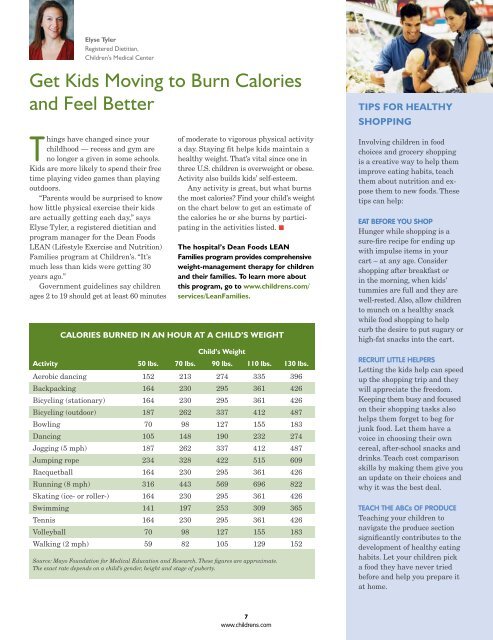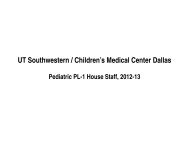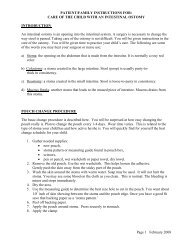NIGhtmAReS vS. SleeP teRRoRS cAR SeAt SAfety SPoRtS ...
NIGhtmAReS vS. SleeP teRRoRS cAR SeAt SAfety SPoRtS ...
NIGhtmAReS vS. SleeP teRRoRS cAR SeAt SAfety SPoRtS ...
You also want an ePaper? Increase the reach of your titles
YUMPU automatically turns print PDFs into web optimized ePapers that Google loves.
elyse tyler<br />
registered Dietitian,<br />
children’s Medical center<br />
Get Kids Moving to Burn calories<br />
and feel Better<br />
things have changed since your<br />
childhood — recess and gym are<br />
no longer a given in some schools.<br />
Kids are more likely to spend their free<br />
time playing video games than playing<br />
outdoors.<br />
“Parents would be surprised to know<br />
how little physical exercise their kids<br />
are actually getting each day,” says<br />
Elyse Tyler, a registered dietitian and<br />
program manager for the Dean Foods<br />
LEAN (Lifestyle Exercise and Nutrition)<br />
Families program at Children’s. “It’s<br />
much less than kids were getting 30<br />
years ago.”<br />
Government guidelines say children<br />
ages 2 to 19 should get at least 60 minutes<br />
of moderate to vigorous physical activity<br />
a day. Staying fit helps kids maintain a<br />
healthy weight. That’s vital since one in<br />
three U.S. children is overweight or obese.<br />
Activity also builds kids’ self-esteem.<br />
Any activity is great, but what burns<br />
the most calories? Find your child’s weight<br />
on the chart below to get an estimate of<br />
the calories he or she burns by participating<br />
in the activities listed. n<br />
the hospital’s Dean foods leAN<br />
families program provides comprehensive<br />
weight-management therapy for children<br />
and their families. to learn more about<br />
this program, go to www.childrens.com/<br />
services/leanfamilies.<br />
cAloRIeS BuRNeD IN AN houR At A chIlD’S weIGht<br />
Activity 50 lbs. 70 lbs.<br />
child’s weight<br />
90 lbs. 110 lbs. 130 lbs.<br />
Aerobic dancing 152 213 274 335 396<br />
Backpacking 164 230 295 361 426<br />
Bicycling (stationary) 164 230 295 361 426<br />
Bicycling (outdoor) 187 262 337 412 487<br />
Bowling 70 98 127 155 183<br />
Dancing 105 148 190 232 274<br />
Jogging (5 mph) 187 262 337 412 487<br />
Jumping rope 234 328 422 515 609<br />
Racquetball 164 230 295 361 426<br />
Running (8 mph) 316 443 569 696 822<br />
Skating (ice- or roller-) 164 230 295 361 426<br />
Swimming 141 197 253 309 365<br />
Tennis 164 230 295 361 426<br />
Volleyball 70 98 127 155 183<br />
Walking (2 mph) 59 82 105 129 152<br />
Source: Mayo Foundation for Medical Education and Research. These figures are approximate.<br />
The exact rate depends on a child’s gender, height and stage of puberty.<br />
7<br />
www.childrens.com<br />
tIPS foR heAlthy<br />
ShoPPING<br />
Involving children in food<br />
choices and grocery shopping<br />
is a creative way to help them<br />
improve eating habits, teach<br />
them about nutrition and expose<br />
them to new foods. These<br />
tips can help:<br />
eat Before you sHop<br />
Hunger while shopping is a<br />
sure-fire recipe for ending up<br />
with impulse items in your<br />
cart – at any age. Consider<br />
shopping after breakfast or<br />
in the morning, when kids’<br />
tummies are full and they are<br />
well-rested. Also, allow children<br />
to munch on a healthy snack<br />
while food shopping to help<br />
curb the desire to put sugary or<br />
high-fat snacks into the cart.<br />
recruit little Helpers<br />
Letting the kids help can speed<br />
up the shopping trip and they<br />
will appreciate the freedom.<br />
Keeping them busy and focused<br />
on their shopping tasks also<br />
helps them forget to beg for<br />
junk food. Let them have a<br />
voice in choosing their own<br />
cereal, after-school snacks and<br />
drinks. Teach cost comparison<br />
skills by making them give you<br />
an update on their choices and<br />
why it was the best deal.<br />
teacH tHe aBcs of proDuce<br />
Teaching your children to<br />
navigate the produce section<br />
significantly contributes to the<br />
development of healthy eating<br />
habits. Let your children pick<br />
a food they have never tried<br />
before and help you prepare it<br />
at home.








